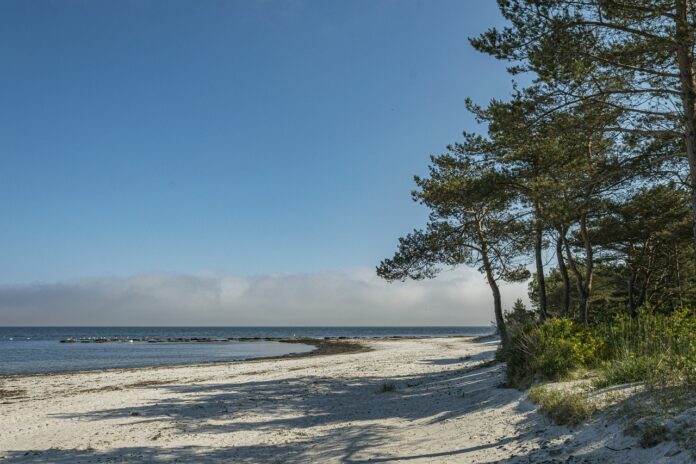Between the Scandinavian Peninsula and Northwestern Europe stretches a powerful water artery once known in ancient times as the Varangian Sea. According to scientists, the geological history of this body of water began over 1 billion years ago. Initially, the Eridanus River formed in this location, originating in modern Lapland and with its delta in the Netherlands.
However, with the onset of glaciation 700,000 years ago, the entire tectonic plate was covered by a thick layer of snow and ice, heavy enough to cause a depression in the Earth’s crust. When temperatures rose again, water flowed into the depression, creating what we now know as the Baltic Sea.
It didn’t immediately resemble its current map depiction: depth, coastline, seabed relief, and other parameters changed over time. Today, the Baltic Sea washes the shores of Russia, Poland, and Germany, delights Sweden and Finland with its gentle waters, and allows residents of Estonia, Latvia, Lithuania, and Denmark to enjoy marine landscapes. It connects to the North Sea through the Danish Straits and is part of the Atlantic Ocean.
Famous Accidents in the Baltic Sea:
- The Sinking of the MV Estonia (1994): The MV Estonia was a ferry traveling from Tallinn to Stockholm when it sank in a storm on September 28, 1994. The disaster resulted in the deaths of 852 people, making it one of the deadliest ferry accidents in the 20th century. The cause of the sinking was attributed to the failure of the bow visor, which allowed water to flood the car deck.
- The Sinking of the MS Scandinavian Star (1990): On April 7, 1990, the MS Scandinavian Star, a ferry traveling from Oslo to Frederikshavn, caught fire. The blaze resulted in the deaths of 159 passengers and crew members. The fire, which was started by arson, caused significant damage to the ship and led to the largest maritime disaster in Scandinavian waters in the 20th century.
Interesting Facts About the Baltic Sea:
- The volume of water entering the sea is about 21,000 km³, with an average depth of 50 meters. These figures are smaller compared to Lake Baikal, considered a lake.
- The Baltic Sea is considered brackish because it is regularly fed by fresh mountain rivers, significantly affecting its composition and fauna. It is home to both marine and freshwater fish.
- The average tidal range is 10-20 cm, which is significantly lower than in other seas.
- The Baltic Sea is considered the cradle of the Russian Empire’s naval fleet, maintaining its military-strategic importance to this day.
- Coastal inhabitants claim that the Baltic Sea has a very calm character: even in bad weather, high waves are rarely seen. However, this is not constant. Official records have noted storms with waves over 10 meters high.
- The northern edge of the Baltic Sea freezes every winter. There have been 20 documented cases when the entire surface was frozen, the most recent being in 1987.
- Germans, Swedes, and Finns refer to the sea as the Eastern Sea, while Estonians call it the Western Sea.
- On the Danish shore of the Baltic Sea is a unique natural tourist attraction known as the “Troll Forest.” This park features trees with bizarrely twisted trunks. Science has yet to explain this phenomenon or replicate it.
- The Baltic Sea floor contains containers of chemical waste, posing a threat of a major ecological disaster. During World War II, many capsules with hazardous contents were buried on the seabed. Now, due to corrosion, toxins and pollutants are slowly leaking out, causing significant harm to the ecosystem and environmental pollution.
- In a specific location where the Baltic and North Seas intersect, you can observe an amazing sight: their waters touch but do not mix due to differing densities. The boundary is clearly visible because of the color difference.
- The Baltic Sea coast is home to 85 million people.
- The Baltic Sea floor is a treasure trove for archaeologists, with Stone Age artifacts that are highly valuable to history. However, retrieving them is extremely challenging.
- Additionally, the depths of the Baltic Sea are rich in amber, and its waters have a very high concentration of dissolved gold.
- Icebreaker Ships: Due to its frequent winter ice cover, the Baltic Sea has a significant role in the history and development of icebreaker ships. These ships are specially designed to navigate through ice-covered waters and maintain shipping routes during winter.
- Baltic Sea States: The Baltic Sea is bordered by nine countries: Denmark, Estonia, Finland, Germany, Latvia, Lithuania, Poland, Russia, and Sweden. Each country has its own coastal culture and history related to the sea.
